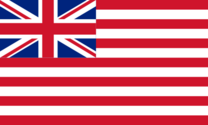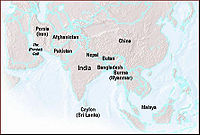East India Company Factories: Difference between revisions
Symorsebrown (talk | contribs) Add internal link |
Symorsebrown (talk | contribs) m Typo |
||
| Line 66: | Line 66: | ||
==== Bencoolen ==== | ==== Bencoolen ==== | ||
[[Bencoolen]] now [http://en.wikipedia.org/wiki/Bengkulu_(city) Bengkulu] on the west coast of Sumatra. The | [[Bencoolen]] now [http://en.wikipedia.org/wiki/Bengkulu_(city) Bengkulu] on the west coast of Sumatra. The British established a factory in 1685 after losing Bantam to the Dutch. | ||
==== Calcutta ==== | ==== Calcutta ==== | ||
Revision as of 17:37, 6 December 2010

| HEIC Factories | |
|---|---|

| |
| See our interactive map of 17th cent HEIC Factories on Google Maps | |
17th century Factories
Listed below are some of the early trading posts set up by the East India Company. The Company initially concentrated on the East Indies spice trade but was vigorously opposed by the Dutch. The Anglo-Dutch Treaty of 1824 saw the cessation of all Dutch activities in the Indian subcontinent and all English activities in the East Indies. See HEIC Early Voyages for details of the expeditions to these trading posts.
Bantam
The first trading post set up in 1603 at Banten, Java by James Lancaster. Initially the factories on the Coromandel Coast reported to Bantam. The factory was attacked by the Dutch in 1682 and closed in 1683.
Tidore
Pulau Tidore in the Moluccas. Founded 1604.
Masulipatam
Machilipatnam on the Coromandel Coast. The first trading post on the subcontinent was founded in 1611.
Surat
Surat in Gujerat. Sir Thomas Roe obtained permission from Emperor Jahangir to found a factory in 1612.
Sambas
Sambas on the northwest Borneo coast founded in 1614.
Tekoo
Tiku West Sumatra founded in 1615.
Burhanpore
Burhanpore in Bengal founded in 1616.
Polaroon
Pulau Run, Banda Islands, Indonesia. Founded 1616.
Calicut
Calicut on the Malabar Coast. Founded in 1616.
Agra
After an unsuccessful mission by William Hawkins, Sir Thomas Roe obtained permission to trade from Agra in 1618.
Patna
Patna in Bihar. A factory was established in 1620 to procure silk and cotton textiles. It later became a source of saltpetre.
Armegon
Armegon (Blackwood Harbour) on the Coromandel Coast. Factory founded in 1626. Modern town is Durgarajupatnam.
Pipley
Pipili, Orissa. Permission granted in 1634 to found a factory.
Madras
Francis Day, the Chief of the Armegon factory, obtained a grant from the local ruler to control a strip of coast at the village of Madraspatnam in 1639. The consrtruction of Fort St George began in 1640.
Balasore
Balasore, Orissa. In 1642 Gabriel Boughton, a surgeon, cured the daughter of Emperor Shah Jehan. As a reward he was given permission to trade at Balasore and Hooghly. The latter was resisted by the Portuguese and did become a factory until 1676.
Cossimbazar
Cossimbazar in West Bengal. Factory founded in 1658.
Acheen
Aceh in North Sumatra. After trading there since 1602, a trading post was founded in 1659.
Dacca
Dacca in East Bengal now Bangladesh. Trading post established 1666.
Bombay
Bombay passed to the British with the dowry of Catherine of Braganza in 1661. The East India Company leased the territory for £10 per annum in 1668.
Hooghly
Hooghly, West Bengal. Originally founded by the Portuguese, the English factory was started in 1676.
Bencoolen
Bencoolen now Bengkulu on the west coast of Sumatra. The British established a factory in 1685 after losing Bantam to the Dutch.
Calcutta
Job Charnock favoured the village of Sutanuti as a trading post. After the difficulties with the Nawab of Bengal had been resolved, an imperial grant was made in 1690 for the British to establish a factory at the location which became Calcutta.
External Links
Historical books on-line
- Letters Received by the East India Company from Its Servants in the East: transcribed from India Office Records Archive.org
- Volume 1 1602-1613 1896 Volume 2 1613-1615 1897 Volume 3 1615 1899 Volume 4 1616 1900 Volume 5 1617 January to June 1901 Volume 6, 1617 July-December 1902
- The English Factories in India: A Calendar of Documents in the India Office, British Museum and Public Records Office by William Foster Archive.org